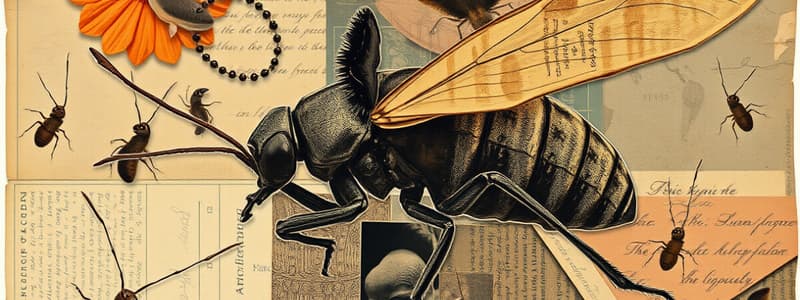Podcast
Questions and Answers
What are basic characteristics that all or most Arthropods share?
What are basic characteristics that all or most Arthropods share?
All Arthropods are invertebrates, have an exoskeleton, segmented bodies, jointed appendages, bilateral symmetry, open circulatory system, one-way digestive system, most reproduce sexually, and most have antennas.
What are the four groups of Arthropods?
What are the four groups of Arthropods?
The four groups of Arthropods are crustaceans, arachnids, centipedes and millipedes, and insects.
What is an exoskeleton?
What is an exoskeleton?
An exoskeleton is an outer shell or skeleton.
What are two advantages of having an exoskeleton?
What are two advantages of having an exoskeleton?
What are two disadvantages of having an exoskeleton?
What are two disadvantages of having an exoskeleton?
What is molting?
What is molting?
Which group of Arthropods does not have antennas?
Which group of Arthropods does not have antennas?
What is the advantage of having a jointed appendage?
What is the advantage of having a jointed appendage?
What is a swimmeret?
What is a swimmeret?
What is a cheliped?
What is a cheliped?
Which group of arthropods are these associated with?
Which group of arthropods are these associated with?
How do crustaceans breathe?
How do crustaceans breathe?
Do crustaceans go through a metamorphosis?
Do crustaceans go through a metamorphosis?
Name four types of arachnids that we studied.
Name four types of arachnids that we studied.
What are the similarities and differences between a mite and a tick?
What are the similarities and differences between a mite and a tick?
Why can scorpions survive in harsh climates?
Why can scorpions survive in harsh climates?
What is one difference between centipedes and millipedes?
What is one difference between centipedes and millipedes?
What are the three sections of an insect's body called?
What are the three sections of an insect's body called?
To which body section of an insect's body do the legs attach?
To which body section of an insect's body do the legs attach?
How many stages do insects go through during a complete metamorphosis?
How many stages do insects go through during a complete metamorphosis?
What is the name of each stage during a complete metamorphosis?
What is the name of each stage during a complete metamorphosis?
What is a gradual metamorphosis?
What is a gradual metamorphosis?
How is a gradual metamorphosis different from a complete metamorphosis?
How is a gradual metamorphosis different from a complete metamorphosis?
Give an example of an animal that goes through a complete metamorphosis.
Give an example of an animal that goes through a complete metamorphosis.
Is a nymph part of a complete or a gradual metamorphosis?
Is a nymph part of a complete or a gradual metamorphosis?
Give an example of an animal that goes through a gradual metamorphosis.
Give an example of an animal that goes through a gradual metamorphosis.
Flashcards are hidden until you start studying
Study Notes
Basic Characteristics of Arthropods
- Arthropods are invertebrates with an exoskeleton and segmented bodies.
- Possess jointed appendages and exhibit bilateral symmetry.
- Have an open circulatory system and a one-way digestive system.
- Most reproduce sexually and possess antennas.
Groups of Arthropods
- Four primary groups: crustaceans, arachnids, centipedes and millipedes, insects.
Exoskeleton
- Serves as an outer shell, providing protection and preventing water loss.
- Two main advantages: body protection and moisture retention.
Disadvantages of Exoskeleton
- Limits movement and requires molting to grow, necessitating shedding and regrowth.
Molting
- The process of shedding an old exoskeleton to accommodate growth.
Arachnids
- Unique among arthropods for lacking antennas.
Jointed Appendages
- Jointed appendages enhance mobility despite the presence of an exoskeleton.
Crustacean Adaptations
- Swimmerets function like flippers for swimming.
- Chelipeds are used for capturing food and defense.
Breathing in Crustaceans
- Utilize gills for respiration, diffusing oxygen in moisture.
Metamorphosis in Crustaceans
- Most undergo metamorphosis during their life cycle.
Types of Arachnids
- Includes spiders, mites, ticks, and scorpions.
Mites vs. Ticks
- Mites are microscopic and primarily eat plants and fungi; ticks are macro-sized and feed on blood.
- Mites have a soft exoskeleton, while ticks possess a harder exoskeleton.
Scorpion Resilience
- Survive harsh conditions by slowing metabolism, requiring minimal food, and regulating oxygen intake.
Differences in Legs
- Centipedes have one pair of legs per segment; millipedes have two pairs per segment.
Insect Body Structure
- Three sections: head, thorax, and abdomen.
- Legs attach to the thorax.
Insect Metamorphosis
- Complete metamorphosis involves four stages: egg, larva, pupa, and adult.
- Gradual metamorphosis consists of three distinct changes.
Example of Metamorphosis
- Butterflies undergo complete metamorphosis, while termites exhibit gradual metamorphosis.
- Nymphs are associated with gradual metamorphosis.
Studying That Suits You
Use AI to generate personalized quizzes and flashcards to suit your learning preferences.




